 This review is part of the Cameras of the Dead series which I have been publishing every year on Halloween and “Halfway to” Halloween, featuring three cameras that I’ve wanted to review that either didn’t work, or was otherwise unable to shoot.
This review is part of the Cameras of the Dead series which I have been publishing every year on Halloween and “Halfway to” Halloween, featuring three cameras that I’ve wanted to review that either didn’t work, or was otherwise unable to shoot.
I am republishing each of those individual reviews this October in anticipation of this Halloween’s Cameras of the Dead post as a way to revisit the cameras of the past that allows them to be properly indexed on the site.
This is a Kowa SE-T 35mm Single Lens Reflex camera made by Kowa Optical Works around 1965. The SE-T was part of a range of leaf shutter SLR cameras made by Kowa from about 1960 – 1972. Earlier Kowa SLRs like the SE-T had a fixed lens that had a variety of screw in adapters to change the focal length of the built in 50mm lens. Later Kowa SLRs came with a proprietary bayonet lens mount. Kowa SLRs like the SE-T were nicely designed and compact SLRs that came with good lenses and a competitive list of features, but over the years have suffered the same fate as many leaf shutter SLRs which is poor reliability.
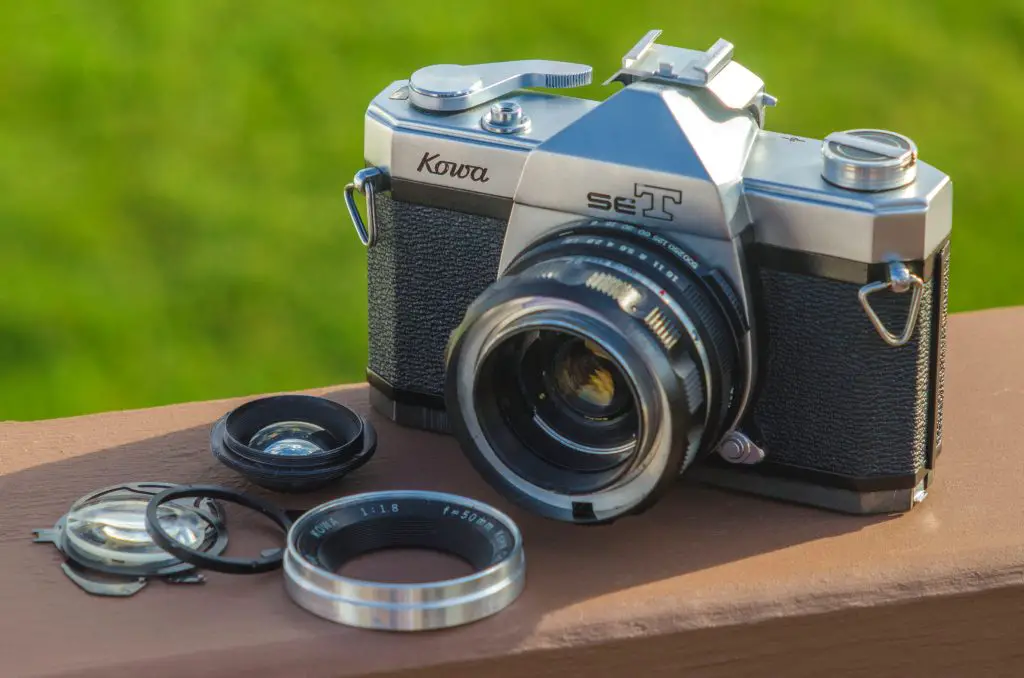 Film: 135 (35mm)
Film: 135 (35mm)
Lens: Kowa 50mm f/1.8 6-elements coated
Focus: 3 feet to Infinity
Viewfinder: Fixed SLR Pentaprism
Shutter: Seiko MXV Leaf
Speeds: B, 1 – 1/500 seconds
Exposure Meter: TTL CdS Coupled Meter
Battery: 1.35v PX625 Mercury Battery
Flash Mount: Accessory Cold Shoe and PC MX Sync
Manual: http://www.cameramanuals.org/pdf_files/kowa_se_t.pdf
My Thoughts

This is the second leaf shutter SLR to be featured in the “Cameras of the Dead” series, and I’m starting to think there’s a correlation there. In my review for the Kodak Retina Reflex III, which was another leaf shutter SLR made by Kodak AG, I found that some of the same challenges with that camera applied to the Kowa SE-T. SLR cameras have almost always had a focal plane shutter, usually made of cloth, which functions as a barrier from light hitting the unexposed film loaded into the camera. Leaf shutters on the other hand were very popular in other camera designs over the years, including rangefinders, TLRs, and box cameras since there is no need to have light pass through the shutter until the instant the photo needs to be taken.
While it might seem that using a leaf shutter on an SLR might have been a straightforward swap, it actually was quite complicated. For one, in a focal plane shutter, the reflex mirror which reflects light up into the viewfinder is in front of the shutter. The shutter can remain shut, blocking light from the film plane up until the moment of exposure. On a leaf shutter camera, the shutter is in front of the reflex mirror, which means that in order for light to be reflected up into the viewfinder, both the shutter and aperture iris must remain wide open while composing. Since the shutter is open at all times while composing an image, a separate flap called the “capping plate” must fold down behind the mirror, blocking light from entering the film plane and prematurely exposing the film. The image to the right shows the capping plate in it’s closed position in the film compartment blocking light from hitting the film during composition.
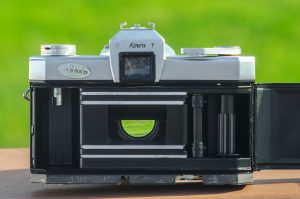
During storage, or when the shutter is not cocked, the shutter remains closed, and the mirror and capping plate remain in the upright position, blocking all light from entering the viewfinder. In order to see through the viewfinder, you must first advance the film using the wind lever on the bottom of the camera.
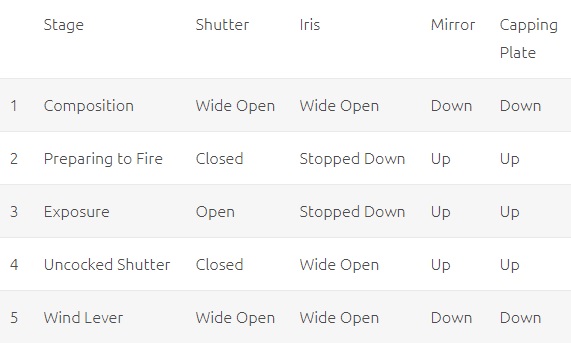 Then, when the photographer is ready to capture an image, a convoluted series of events must unfold to first close the shutter, then the capping plate and the reflex mirror flip up out of the way, the aperture iris stops down to it’s selected setting, the shutter reopens to expose the film for whatever length shutter speed has been selected, then close again to stop the exposure, all while happening upon the moment the shutter release button is pressed. This whole sequence takes approximately 1/50th of a second to complete which isn’t a huge amount of time, but the delay could cause problems shooting moving objects as the image would be captured 1/50th of a second after you intended it to.
Then, when the photographer is ready to capture an image, a convoluted series of events must unfold to first close the shutter, then the capping plate and the reflex mirror flip up out of the way, the aperture iris stops down to it’s selected setting, the shutter reopens to expose the film for whatever length shutter speed has been selected, then close again to stop the exposure, all while happening upon the moment the shutter release button is pressed. This whole sequence takes approximately 1/50th of a second to complete which isn’t a huge amount of time, but the delay could cause problems shooting moving objects as the image would be captured 1/50th of a second after you intended it to.
This following YouTube video shows the shutter action of 7 different leaf shutter SLRs. Unfortunately no Kowas were used in the video, but they basically work the same way. On a side note, I want to know where this guy’s supplier is to have that many perfectly working leaf shutter SLRs all at once!
If this sounds like an overly complicated way to make an SLR, you’re right. While overall it did work, the chances for failure were higher for leaf shutter SLRs compared to focal plane SLRs due to the extra moving parts, and the cost to get them repaired was substantial. While I could not find any evidence of this, I would suspect that many repair shops back then might have declined service on models like these for this very reason.
Despite these challenges, that didn’t stop companies like Kodak, Zeiss-Ikon, and Kowa from releasing a variety of leaf shutter SLRs in the 1950s and 60s. Perhaps it was the wide availability of so many quality leaf shutters out there, or that leaf shutters do have the advantage of flash sync capability at all speeds, versus the standard 1/60th speeds of most focal plane shutters of the era. Whatever the reason for the design of the leaf shutter SLR, it proved to be an unreliable way to build a camera and as such, very few are found in working condition today.

This Kowa SE-T actually came to me with a semi-working shutter. When I first received it, I was pleased to see that the shutter did indeed fire, but it was slow at all speeds. In an attempt to try and flush it with lighter fluid, I ended up making the camera worse. It got to the point where the film advance got completely jammed and wouldn’t cock or fire the shutter at all. Back in the fall of 2016, I attempted to disassemble this camera in the hope that I could discover what went wrong with it, and well, I failed. The Kowa SE-T is beyond repair and frankly, I don’t even think I’d want to use it as the constant worry of another shutter failure would be always on my mind while shooting. It is for this reason, that this Kowa SE-T is here as a Camera of the Dead.
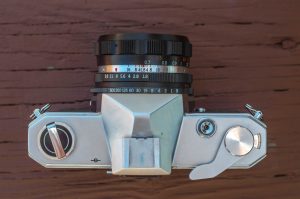
If I look past the shutter and reflect upon everything else about the camera, I can say that compared to the Retina Reflex III, the Kowa SE-T has a much cleaner design and it’s controls are easier to use. For one, the SE-T looks like most other SLRs of the era. If no one were to tell you, you would assume this was just another run of the mill Japanese made SLR. All Kowa SLRs are generally compact and lightweight. Compared to the Retina Reflex III, the Kowa SE-T is shorter, and weighs less.
In addition to a more compact design, all of the necessary controls are exactly where you’d expect them to be. The shutter release, exposure counter, and wind lever are all on the right side of the top plate, both the shutter speed and aperture rings are on the lens just like they are on many other cameras, and even the ASA speed selector is on the lens in a similar position to where it resides on most cameras of the era. The Retina Reflex however, has it’s controls in seemingly random places on the camera, the worst being the aperture selector which is an independent wheel on the bottom of the lens mount.
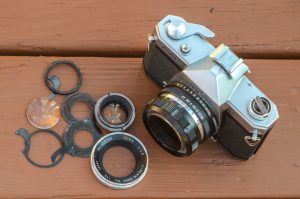
The SE-T has modern features like a fully coupled match needle TTL CdS exposure meter visible in the viewfinder, a bright Fresnel focus screen with a ground glass circle and split image focus aides, M and X flash sync, and a self timer.
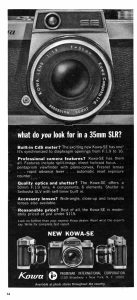
To be perfectly honest with you, I find it to be a damn shame that this camera didn’t come with a focal plane shutter as it’s design, controls, and size make for an extremely compact and easy to use camera. I honestly believe that Kowa SLRs could have been pretty popular in the years after their release as the rest of the camera seems to be well made, and their 6-element coated lenses suggest excellent images. It was not to be however, and what we have now is a curious relic from a short lived era of leaf shutter SLRs that look good on a shelf, but not much else.
I was unable to find any kind of sales estimates for Kowa’s leaf shutter SLRs, but for them to have been in production for over a decade, I have to imagine that they sold reasonably well. Perhaps they were marketed as an entry level SLR for photographers ready to make the switch from a rangefinder to an SLR, without investing large amounts of money into the system cameras made by other companies. In the ad to the left from 1964 for the earlier Kowa SE (the only difference between the SE and SE-T is the lack of a through the lens CdS meter), the big selling point was the camera’s value. At a list price of $115, the Kowa SE was a bargain compared to other SLRs with similar features. When adjusted for inflation, $115 in 1964 is like $903 today. Not cheap, but nowhere near the asking prices of cameras like the Nikon F, Minolta SR-7, or Canon FX.
Kowa’s only other camera at the time was their Kowa Six, which was a medium format SLR, similar to models made by Bronica and Mamiya. The Kowa Six was in production until around 1974, at which time, the company would completely exit the camera business. After that, their product line seemed to switch to other optics products such as sporting scopes, binoculars, and ophthalmic diagnostic equipment. The company still exists today both in North America as Kowa-USA, and in Japan as Kowa Company Limited.
Related Posts You Might Enjoy
External Links
http://camera-wiki.org/wiki/Kowa_SET
https://bygonesupplyco.com/products/kowa-set-35mm-slr-film-camera-vintage-1960s

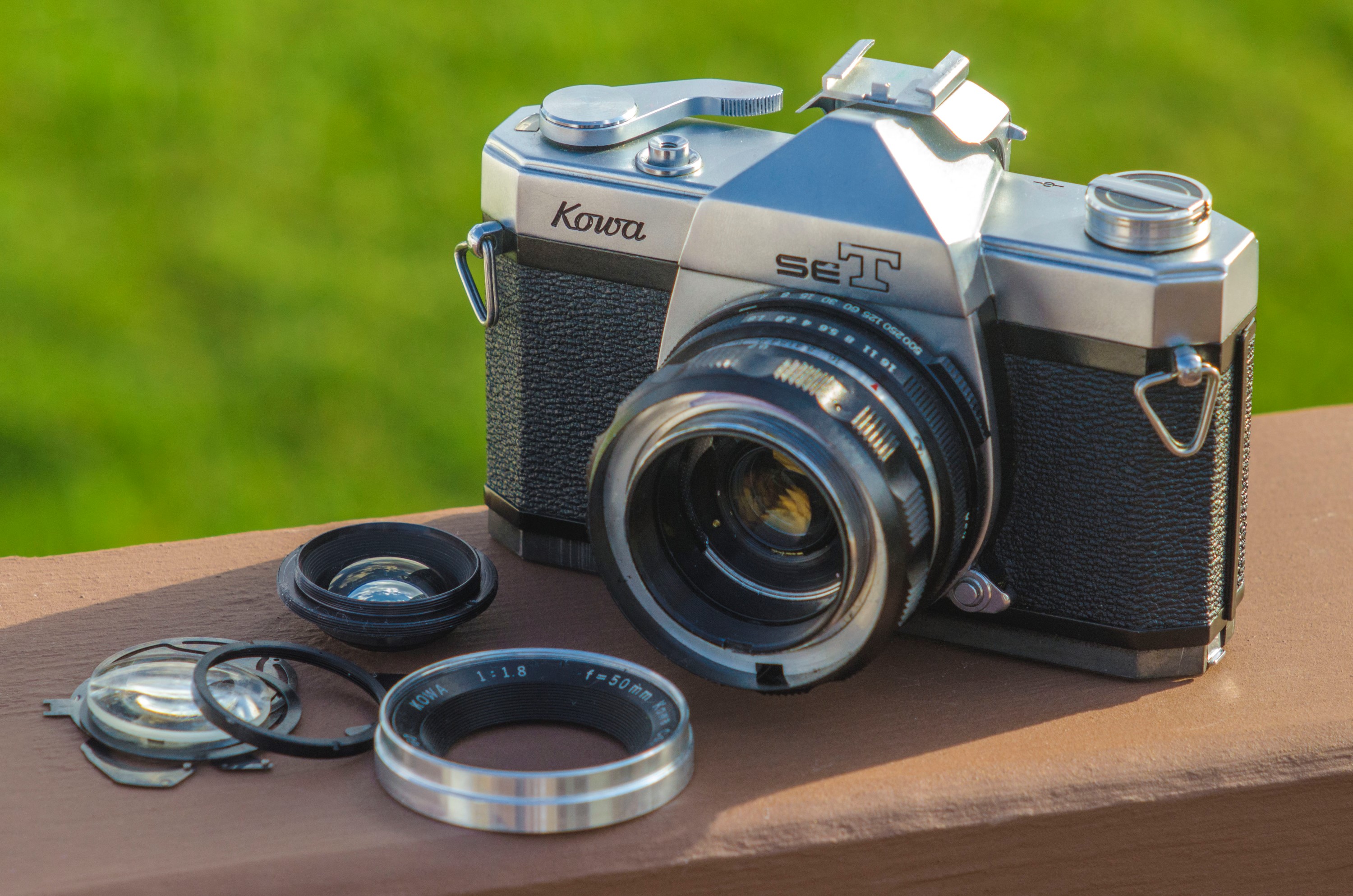
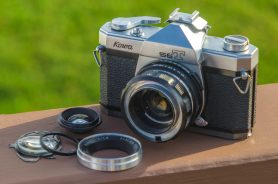
I have a small collection of Kowa’s, six of which are SLR’s I also have two rangefinders and a viewfinder camera. They all work with the exception of my all black SET which will fire the shutter as soon as the wind on lever reaches the end of its stroke. It is a pity because the all black Kowa SLR’s are quite rare.
I enjoyed reading your article and I have to say they are nice to use with one exception. They have one of the loudest shutters I have ever come across.
Hello, thank you for the great report! I am also a big fan of the Kowa cameras. I have a Kowa SE (without TTL) that still works very well. I love the complex shutter release sound of the SLR cameras with leaf shutter. I would have a question. I have the original wide angle and telephoto attachments from Kowa. Do I need to correct the exposure when using the lens attachments (the Kowa SE does not have TTL, I could not find anything in the manual). Many thanks, Dr. med. S. Magliozzi
Thanks for the comments. No, you would not need to correct for exposure with the accessory lenses as the camera can already index what aperture you have it set at. Now, if you were to add any kind of colored or neutral density filter, then you would need to. Truthfully, even if the meter on your camera responds to light, I wouldnt trust it. I shoot a lot of old cameras and even those with accurate meters, I use my own meter separately from the camera.
Thanks for the kind reply! I imagined that the lens attachments also swallow some light. Can you explain to me why this is not so? Do you know anything about the image quality of the original telephoto and wide angle lens attachments from Kowa. Why would you always use an external light meter? My father had been taking pictures with a Kowa SE my whole childhood. The pictures were really great. I wouldn’t feel that metering was a problem, even though the Kowa SE doesn’t have TTL. What other model of Kowa would you recommend to me? Thank you very much from Switzerland! Where do you live?
I also have the auxiliary lenses but have never used them. Mine are not made by Kowa but by another lens maker but I can’t remember who. My biggest problem at the moment is to find someone who can repair my all black SET here in the UK. I know it will be expensive but I would love to have it working. I bought it knowing it had problems but it is the only all black Kowa SLR that I have seen.
Thank you very much for your information! I also have the third-party lens attachments in addition. The originals from Kowa have about three times the volume. If you actually want to use them for photography, it is worth buying the original ones. I think the image quality is definitely better with the originals. For repairs it is quite bad in Switzerland. There is almost nothing not only for a Kowa camera. I would look once in Germany. There are more repairs than in Switzerland.